| |
|
|
|
|
|
|
|
|
|
|
| |
| |
 |
|
| |
田润德
编译文/图 2020-05-21
20:36 |
|
| |
|
|
|
|
| |
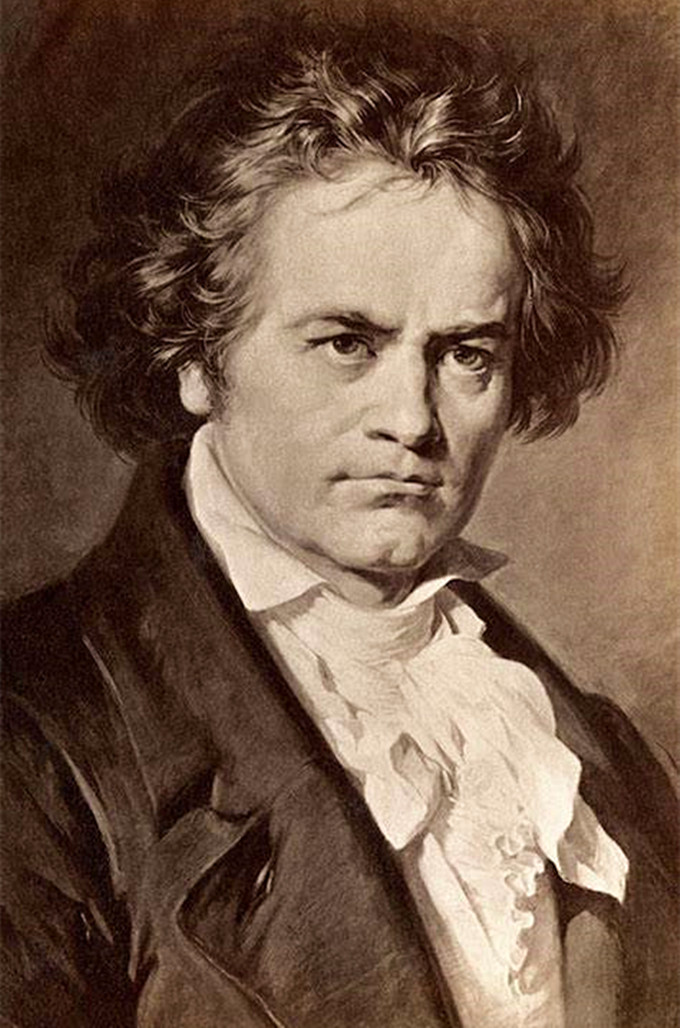 |
|
|
|
| |
路德维希·凡·贝多芬 (Ludwig van Beethoven 1770—1827) |
|
|
|
| |
|
|
|
|
| |
林品任演奏贝多芬《d大调小提琴协奏曲》
|
|
|
|
| |
Richard Lin
Beethoven: Violin Concerto in D major, Op. 61
|
|
|
|
| |
原曲: Beethoven: Violin Concerto in D major, Op. 61 演奏者:
林品任演奏乐器: 小提琴简介补充: 2016年第15届维尼奥夫斯基大赛-决赛-林品任世界四大小提琴协奏曲之一,是我最喜欢的小提琴协奏曲 :) |
|
|
|
| |
|
|
|
|
| |
音乐历史上的今天
1982年5月21日,贝多芬的小提琴协奏曲被苏联作曲家阿尔弗雷德·施尼凯特(Alfred
Schnittke)配上一首不协和的华彩后出现在唱片中,该华彩包含了许多其它协奏曲的片段。指挥内维尔·马里纳称之为“一种对于贝多芬乐思在20世纪末可能形态的当代幻想。”
贝多芬用他的小提琴协奏曲,创造了一个全新的小提琴语法。因此,可以认为贝多芬创作了小提琴史上最伟大的小提琴协奏曲。
D大调小提琴协奏曲,创作于1806年,是贝多芬唯一的小提琴协奏曲作品,被后人誉为小提琴协奏曲之王。这部作品旋律柔美晴朗、格调清新高雅、气魄壮阔宏大。正如德国当代的小提琴家安妮一索菲·穆特在她自己的唱片说明书中所说:“尽管在贝多芬的作品中小提琴作品可以说是寥寥无几,但贝多芬仍然是最为伟大的小提琴文献作曲家。在他的小提琴协奏曲里面,贝多芬为演奏家提供了更多的韵味因素。在这里他创造了全新的小提琴语法。因此,可以认为贝多芬创作了小提琴史上最伟大的小提琴协奏曲。
据一般认为,这是贝多芬在与特蕾莎·布鲁斯威克小姐热恋期间的作品,因此应该是贝多芬一生之中在感情方面最为热情洋溢甚至可以说是最为幸福快乐的少数时期之一。名声赫赫的钢琴作曲大师和演奏大师贝多芬,就像他的一生中一再表现出来的那样,选用小提琴来表达自己内心深处最为私密的情愫。
有据可查的是,在美好的1
806年,我们的路易(在这种情况下,确实应当这么称呼贝多芬)在特蕾莎·布鲁斯威克小姐家的庄园里度过了一个美好的夏天。在他一生中这至为难得明朗的日子,其馨香渗透在这部作品的每一个角落中,真可以称得上是“万人丛中一握手,使我衣袖十年香”——可止十年,它一直飘香了一个又一个世纪。
不能不强调的是,真正的爱情之所以可贵,就因为它是一座桥梁而不是目标,以其尘世的手,指向所有美好的事物,从而超越了爱情本身。
《D大调小提琴协奏曲》采用三乐章形式。
第一乐章:从容的快板。音乐作品的开始是四声轻柔的定音鼓。据说,这个音响是贝多芬深夜作曲时,从邻居的敲门声里获得的灵感,后来贝多芬又把这几声敲击声用到《“热情”奏鸣曲》和《第五交响曲(“命运》里,也就是著名的命运之神叩门声。当然,这个传说可能忽视了,贝多芬小提琴协奏曲的“1806年性格”(指这一年写作的以典雅美好为基调的第四钢琴协奏曲、情意款款的第四交响曲,以及经过修改后上演的歌颂女性的《菲德里奥》)。
《“热情”奏鸣曲》与《第五交响曲“命运”》里的敲门声,众所周知是十足粗暴的命运之神不速而至。而在贝多芬的小提琴协奏曲里,贝多芬印章似的“敲门声”,更像一个优雅女士的敲门声。反复欣赏,也许更加形象的说法应当是:也许优雅的脚步声刚刚走近过来,还没有走到门前,但是敲门声在等待者的想象里和盼望里出现。
我们可以反反复复来倾听,以掌握或者说推测贝多芬在他不同人生阶段,不同心情与结晶的不同风格——小提琴协奏曲中的这个定音鼓节奏在第一乐章里反复出现了7()余次,而从始至终,这个乐章的音乐提供了一种弥漫着的安详,几乎触手可及的香气,以及一颗温柔的、等待中的心灵怦然而动。
第二乐章:小广板。抒情诗一般的变奏曲。完全可以看作是独奏与乐队之间的交响式对话。贝多芬还从来没有写出过如此美丽恬淡的温存乐章。也许只有勃拉姆斯的小提琴协奏曲的第二乐章的温柔如水,可以与此乐章进行比较,但是贝多芬一点儿也没有勃拉姆斯那种克制的个人温婉与淡淡的时代哀伤。贝多芬根本就不需要克制,沧海月明,蓝田日暖,玉也生烟,凌波微步,罗袂生尘…..
在本乐章的中段,音乐主题朴素而天真,吟咏着,歌唱着,热情在空间之中弥漫荡漾……妙不可言之处,仿佛乐队在沉思中步入无我之境,而独奏部的“点评”,云飞雪落,春絮漫天。从头至尾,曲调流畅,淳朴天然,表情丰富而微妙。
第三乐章:轻快而辉煌的回旋曲,带有奏鸣曲的味道。基本主题轻快活泼,情感在欢欣地奔跑,不时夹着柔情倾诉。快乐与幸福感完全洋溢在表情上,充满自发的活力。乐章的最后留给独奏小提琴一简短紧凑的华彩,把音乐推向尾声光辉灿烂的高潮。
这神奇的作品,充分发挥了小提琴灵敏、神奇、感人的特质。营造了一种特别的平静,犹如万里晴空尽人一汪清湖,我们已经习惯见到的那种贝多芬式的沉郁无常的情绪一扫而光,原来矛盾、对立就是和谐、统一的变体。
《D大调小捉琴协奏曲》于极仓促的时间里,在1806年12月21日创作,小提琴家克莱门蒂两天后就上台首演了。克莱门蒂少时就表现出惊人的音乐才能,九岁时就开始公演,22岁就成为维也纳剧院的首席小提琴和乐队指挥。他才艺颇佳,名振一方,经常喜欢在音乐会上搞一些炫技的小花样,而且他的演奏风格优美洲震、精细雅致,这些特点多少影响到贝多芬创作《D大调协奏曲
》的态度。
然而1806年12月23日的首演,由于准备过于仓促,并算不上是成功。除了几位二流的评论家发表了一点言语不详的评论之外,并没有产生其他反响,有的评价说它是“某些不生动的乐句在无休止的重复中容易使人厌倦”。此后的几十年里,几乎无人再问津这部协奏曲,算起来也大概只有五六次演出。
直到首演的38年之后,才因为门德尔松在家乡莱比锡的指挥演出而重出江湖。当时担任独奏的,是只有13岁的约阿西姆。由于约阿西姆和门德尔松对这部协奏曲的艺术魅力的挖掘和表现,才使其大放异彩,演出获得轰动性成功。从此以后,贝多芬的《D大调小提琴协奏曲》在世界舞台上长盛不衰,所有的小提琴演奏家都要通过这首协奏曲来考验自己的艺术表现力。
约阿西姆对作品所作的风格处理是完美的,准确地表现了贝多芬的艺术内涵。目前,为《D大调协奏曲》写的华彩乐段有三个著名的版本,约阿西姆、克莱斯勒和大卫·奥伊斯特拉赫三位小提琴演奏大师的版本。
今日视频:1、林品任演奏贝多芬《d大调小提琴协奏曲》。 |
|
|
|
| |
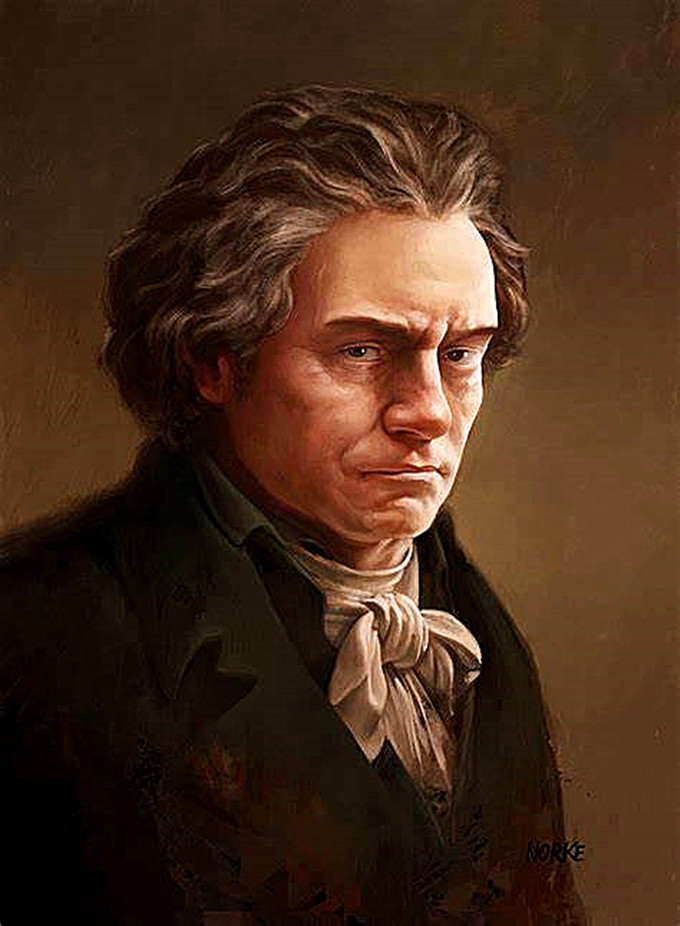 |
|
| |
路德维希·凡·贝多芬 (Ludwig van Beethoven 1770—1827) |
|
|
|
| |
|
|
|
|
| |
Today in the
history of music
On May 21, 1982, Beethoven's violin concerto appeared on a recording by
the Soviet composer Alfred Schnittke with a dissonant flourish that
included many other concertos.Conductor neville mariner called it "a
contemporary fantasy of what Beethoven's musings might have looked like
at the end of the 20th century."
Beethoven used his violin concerto to create a new violin grammar.Thus,
it can be said that Beethoven composed the greatest violin concerto in
the history of the violin.
Lantian warm jade also smoke
Violin concerto in D major, created in 1806, is the only violin concerto
by Beethoven. It is known as the king of violin concerto by later
generations.The melody of this work is soft and sunny, fresh and elegant
style, magnificent and grand.As the contemporary German violinist
anne-sophie mutt said in her own record introduction, "Beethoven is
still the greatest composer of violin documents, although his violin
works are few and far between.In his violin concertos, Beethoven
provides the performer with more elements of flavor.Here he created a
whole new violin grammar.Thus, it can be said that Beethoven composed
the greatest violin concerto in the history of the violin.
It is believed to have been composed during Beethoven's passionate love
affair with miss Teresa Brunswick, and is therefore one of the few
periods in Beethoven's life when he was most passionate and even
happiest.The renowned piano composer and maestro Beethoven, as he had
repeatedly done throughout his life, chose the violin to express his
most intimate feelings.
It is well documented that in the beautiful year 1860, our Louis (in
this case, Beethoven) spent a beautiful summer at the manor of miss
Teresa Brunswick.The fragrance of this rare day of his life permeates
every nook and corner of this work, which may be said to be "a handshake
among thousands of people, which has kept my sleeve perfumed for ten
years" -- but for ten years, it has been perfumed for century after
century.
It cannot be stressed that true love is valuable only because it is a
bridge and not a goal, pointing with its earthly hand to all good
things, and thus transcending love itself.
The violin concerto in D major consists of three movements.
The first movement: deliberate allegro.The music begins with a soft
four-tone timpani.It is said that this sound is Beethoven late at night
composition, from a neighbor's knock on the door in the inspiration,
Beethoven later used the "passion" sonata and the fifth symphony (" fate
", also known as the fate of the god knock on the door.Of course, the
legend may have overlooked the "character of 1806" of Beethoven's violin
concerto (the fourth piano concerto, the fourth symphony, the fourth
symphony, and the revised "fredrio," which celebrated women).
The knock on the door in the "passion" sonata and "destiny" in the fifth
symphony is known to be the most brutal of fates.In Beethoven's violin
concerto, Beethoven's chop, "knock on the door," is more like an elegant
lady's knock on the door.Perhaps it would be more figurative to say:
perhaps the elegant step has just come close, and has not yet reached
the door, but the knock appears in the imagination and expectation of
the person waiting.
We can listen to repeatedly, to master or speculate that Beethoven in
his different life stage, different mood and crystallization of
different styles - violin concerto in the timpani rhythm repeatedly
appeared in the first movement over 7 (), and from beginning to end, the
movement of music provides a kind of filled with peaceful, almost within
reach of aroma, and a gentle, waiting for the heart become really
interested in.
The second movement: small Canton.Lyric variations.It can be thought of
as a symphonic dialogue between the solo and the orchestra.Beethoven had
never written such a beautiful and mild music.Perhaps only the second
movement of Brahms's violin concerto is as tender as water, but
Beethoven had none of Brahms's restrained personal tenderness and mild
contemporary pathos.Beethoven does not need restraint, the sea is
bright, blue field warm, jade also smoke, lingbo micro step, mei sheng
dust....
In the middle of this movement, the music theme is simple and naive,
chanting, singing, passion in the space filled with ripples...The
wonderful part is as if the band is meditating into a world without me,
while the "comments" of the recital department show clouds flying and
snow falling and the sky filled with spring.From beginning to end, the
melody is smooth, simple and natural, and the expression is rich and
subtle.
The third movement: light and brilliant rondo, with the taste of
sonata.The basic theme is light and lively, the emotion is running
joyously, from time to time with the tender feelings pour out.Happiness
and happiness completely permeated in the expression, full of
spontaneous vitality.The end of the movement is left to the solo violin
with a short, compact flourish that brings the music to a glorious
climax at the end.
This magical work gives full play to the sensitive, magical and moving
qualities of the violin.Created a kind of special calm, as if the sky is
clear and clear, we have been accustomed to see the kind of Beethoven's
mood of melancholy and impermanence swept away, the original
contradiction, opposition is harmony, unity of the variants.
The concerto D minor was composed in a hurry on December 21, 1806, and
the violinist clementi made his debut two days later.Clementi was a
prodigious musician at an early age, performing at the age of nine and
becoming concertmaster and conductor of the Vienna theatre at the age of
22.He was very talented and famous, and often liked to do some little
tricks to show off his skills in the concert. Moreover, his performance
style was excellent in the American earthquake and refined and elegant,
which more or less influenced Beethoven's attitude in composing the D
major concerto.
But the premiere on December 23, 1806, was too hastily prepared to be a
success.There was no response other than a few half-hearted comments
from second-rate critics, some of whom said it was "boring in the
endless repetition of certain inanimate phrases".In the decades that
followed, the concerto was largely ignored, with only five or six
performances.
It was not until 38 years after the premiere that Mendelssohn's
performance in his hometown of leipzig brought him back.The soloist was
joachim, who was only 13 years old.Because of joachim and Mendelssohn's
exploration and expression of the artistic charm of the concerto, the
performance was a sensational success.Since then, Beethoven's violin
concerto in D major has been flourishing on the world stage. All
violinists have to test their artistic expression through this concerto.
Joachim's stylistic treatment of the work is perfect, accurately
expressing the artistic connotation of Beethoven.At present, there are
three famous versions of the cadenza for the D major concerto, by
joachim, Chrysler and David oyster.
Today's video: 1.
Lin pinren performs Beethoven's violin concerto in d major. |
|
|
|
| |
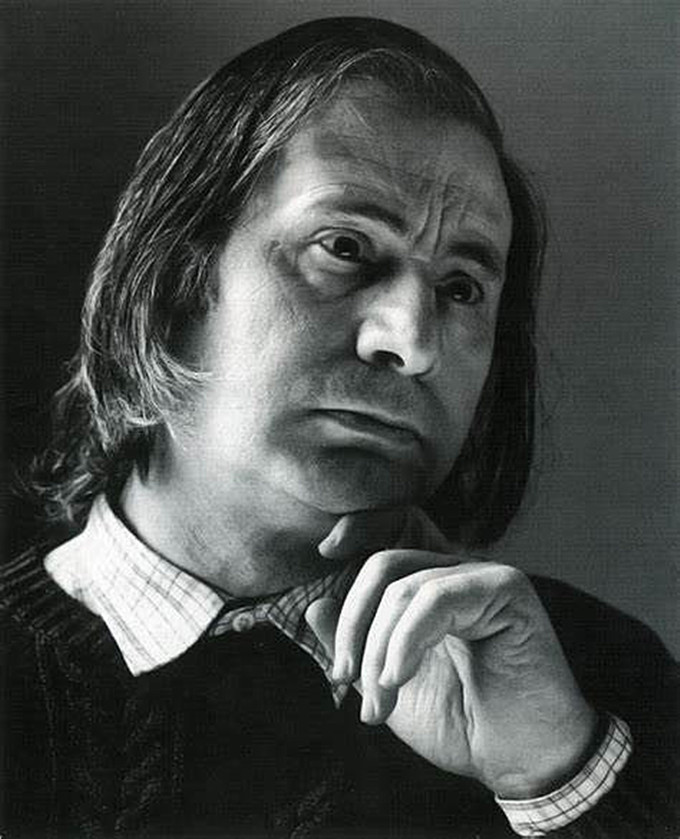 |
|
|
|
| |
阿尔弗雷德·施尼特克(Alfred Schnittke) |
|
|
|
| |
阿尔弗雷德·施尼特克(Alfred
Schnittke)出生于伏尔加河上的日耳曼人自治区恩格斯(Engels)。他在奥地利的维也纳接受钢琴训练,他的父亲曾在那里的一家苏联报纸担任记者。1953年,他来到莫斯科音乐学院,并在1962年至1972年期间担任教职。Schnittke在1961年到…参见完整简历
生于:1934年11月24日,苏联苏维埃社会主义共和国恩格斯,阿西尔·涅姆采夫·波沃尔兹亚[现为恩格尔斯基·rayon,
Saratovskaya oblast,俄罗斯] |
|
|
|
| |
Engels,
an autonomous region for ethnic Germans on the Volga river,
Alfred Schnittke trained as a pianist in Vienna, Austria, where
his father served as a correspondent for a Soviet newspaper. In
1953, he moved on to the Moscow Conservatory and served on its
faculty from 1962 to 1972. Schnittke wrote over 60 film scores
between 1961 and ... See full bio »
Born: November 24, 1934 in Engels, ASSR nemtsev Povolzhya,
RSFSR, USSR [now Engelsskiy rayon, Saratovskaya oblast, Russia] |
|
|
|
| |
|
|
|
|
| |
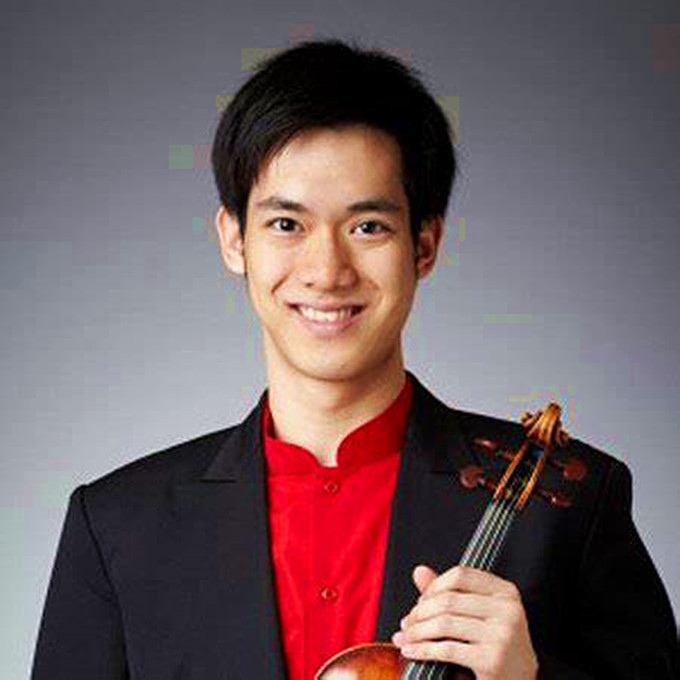 |
|
| |
林品任(Richard Lin) |
|
|
|
| |
林品任(Richard Lin,1991年7月6日),出生美国,后随父母返台。4岁学习小提琴,2007年追随Gregory
Lee(李东亨)前往美国深造,2008年考取美国柯蒂斯音乐学院,师事Aaron
Rosand。2013年起就读于美国茱丽亚音乐学院,师事Lewis
Kaplan。为2011年新西兰麦可希尔国际小提琴大赛银牌得主,2013年日本仙台国际音乐大赛冠军得主,2015年姚阿幸国际小提琴大赛第三名得主,以及2018年第十届美国印地安纳波里斯国际小提琴大赛金牌(首位获得此殊荣之华人)。
林品任曾與多個樂團於著名音樂廳演出;當中包括2014年首度於東京三得利音樂廳與東京交響樂團及指揮飯森範親合作,以及與世界各地的樂團合作,如NDR電台愛樂、上海交響樂團、波蘭波茲南愛樂、羅茲愛樂、波蘭波羅的海愛樂、名古屋愛樂、仙台愛樂等。
2013年,林品任與仙台愛樂及指揮費洛特推出首張專輯,收錄貝多芬、巴托克及布拉姆斯的作品,由Fontec發行。翌年他與弟弟—鋼琴家林品安,合作灌錄全套布拉姆斯鋼琴及小提琴奏鳴曲;他們二人亦常於台灣及日本舉行獨奏會,甚受兩地觀眾愛戴。
曾获奖项
△2001年: 荣获全国学生音乐比赛台中市小提琴国小B组第一名。
△2004年: 荣获台湾弦乐团第五届小提琴比赛国中组第一名,并于国家音乐厅合作演出莫札特第三号小提琴协奏曲。
△2007年: 荣获台中二中协奏曲大赛第一名,并于台中二中音乐厅合作演出柴可夫斯基小提琴协奏曲。
△2008年: 美国Oklahoma Music Olympic" Buttram
Competition"小提琴第一名及大赛总冠军(Overall Winner)
△2010年: 荣获第二十二届奇美艺术奖
△2011年: 荣获第六届新西兰麦可希尔国际小提琴大赛银牌
△2013年: 荣获第五届日本仙台国际音乐大赛冠军
△2015年: 荣获第一届新加坡国际小提琴比赛第二名
△2015年: 荣获第九届汉诺威姚阿幸国际小提琴大赛第三名
△2016年: 荣获第一届上海艾萨克斯特恩国际小提琴大赛第五名
△2016年: 荣获维尼奥夫斯基国际小提琴大赛第五名
△2018年: 荣获第十届美国印地安纳波里斯国际小提琴大赛金牌(首位获得此殊荣之华人)。 |
|
|
|
| |
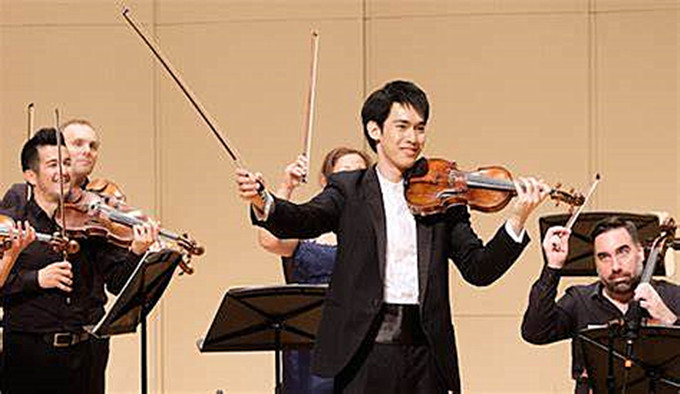 |
|
| |
林品任(Richard Lin) |
|
|
|
| |
Richard Lin (July 6,
1991) was born in the United States and returned to Taiwan with
his parents.He studied violin at the age of 4. In 2007, he
followed Gregory Lee (Lee dong heng) and went to the United
States for further study. In 2008, he was admitted to the Curtis
institute of music in the United States, where he studied with
Aaron Rosand.Since 2013, I have been studying at the American
Julia conservatory of music under the tutored of Lewis Kaplan.He
was the silver medalist of the 2011 Michael hill international
violin competition in New Zealand, the champion of the 2013
sendai international music competition in Japan, the third
winner of the 2015 yao ahsin international violin competition,
and the gold medal of the 10th Indianapolis international violin
competition in 2018 (the first Chinese to win this honor).
Lin has performed with many orchestras in famous concert
halls.Among them, I first cooperated with the Tokyo symphony
orchestra and its conductor fanch iisen at suntory concert hall
in Tokyo in 2014, as well as with orchestras from all over the
world, such as the radio NDR philharmonic, Shanghai symphony
orchestra, poznan philharmonic, rhodes philharmonic, Baltic
philharmonic, Nagoya philharmonic, sendai philharmonic, etc.
In 2013, Lin, together with sendai philharmonic and conductor
feilot, released his debut album, featuring works by Beethoven,
bartok and Brahms, by Fontec.The following year, he and his
brother, the pianist Lin pin an, recorded a full set of Brahms
sonatas for piano and violin.They also gave recitals in Taiwan
and Japan, where they were well received by audiences.
Once his awards
2001: won the first prize in group B of taichung violin national
primary school in the national music competition.
2004: won the first prize of national middle school group in the
fifth violin competition of Taiwan string orchestra, and
performed Mozart no. 3 violin concerto in national concert hall.
2007: won the first prize in taichung no. 2 middle school
concerto competition, and performed Tchaikovsky violin concerto
in taichung no. 2 middle school concert hall.
△ 2008: violin first place and Overall Winner of the Oklahoma
Music Olympic "Buttram Competition"
2010: won the 22nd chi mei art award
△ 2011: silver medal in the 6th New Zealand McChill
international violin competition
△ 2013: won the fifth sendai international music competition,
Japan
△ 2015: won the second place in the first Singapore
international violin competition
△ 2015: won the third place in the 9th Hanover yao a xing
international violin competition
△ 2016: won the fifth place in the first Shanghai isaxton
international violin competition
△ 2016: won the fifth place in the veniovsky international
violin competition
△ 2018: won gold medal in the 10th indiapolis international
violin competition (the first Chinese to win the title) |
|
|
|
| |
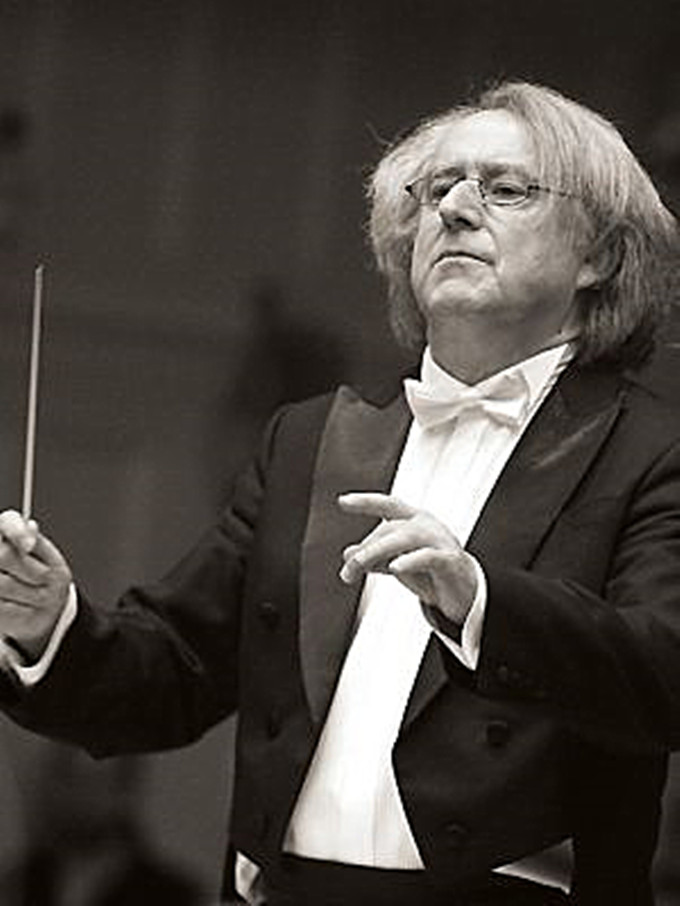 |
|
|
|
| |
马列克
皮雅罗夫斯基(marek pijarowski) |
|
|
|
| |
马列克
皮雅罗夫斯基—波兰著名指挥家、教授(波兰罗兹爱乐乐团总监)。
他成为下西里西亚省的文化机构的领导。当波兰恢复独立时,当地的歌剧管弦乐队演奏交响乐。他的音乐深深地影响了世界上几代音乐家。他为不同的唱片公司录制了许多张专辑。 |
|
|
|
| |
Uwertura
(1829) do opery „Wilhelm Tell” zawsze robi ogromne
wrażenie. Jej dramatyczna narracja rozwija się od
lirycznego prologu, aż po finał zwiastowany sygnałem
trąbki. Dwa pozostałe punkty programu także cieszą
się niesłabnącą popularnością. Fantazja Brucha
(1880) jest dowodem fascynacji niemieckiego
kompozytora szkocką muzyką ludową, która opracowana
została w sposób wirtuozowski, co zadowala w pełni i
wykonawcę, i słuchacza. Słowiańskie brzmienie da się
usłyszeć w Tańcach symfonicznych (1940)
Rachmaninowa. To ostatni utwór rosyjskiego mistrza
będący podsumowaniem jego dokonań twórczych.
Zestawia w nim kompozytor dwie symboliczne melodie:
Dies irae oraz „temat Zmartwychwstania” ze swoich
Nieszporów. |
|
|
|
| |
|
|
|
|
| |
未得原作者编者授权严禁转载www.mt77.com任何内容 |
|
|
|
|
|
|
|
|
|
|
|
|
|
|


